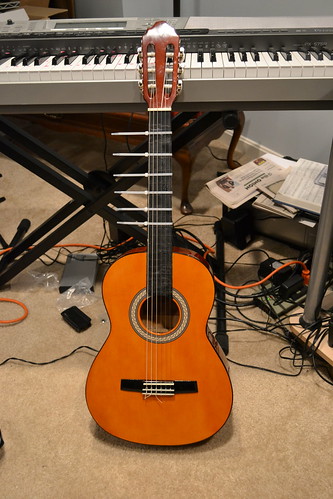December 6, 2011
[2:29]
[ Download ]
Instruments: Valencia 3/4-scale Classical Guitar (modified to Bohlen-Pierce scale), FL Studio 10: Convolver plugin + bass and triangle samples.
For a while, I've been meaning to try composing music in the Bohlen-Pierce scale. Using FL Studio, I had previously been able to modify synthesizers and sample-based instruments to the scale, but since my primary instrument is guitar, I found it difficult to compose using those (somewhat artificial-sounding) keyboard-based instruments.
After running across a video on YouTube showing that you could use zip ties to create temporary frets on a defretted guitar neck, I decided I felt comfortable enough to buy a cheap guitar and perform the operation to turn it into a Bohlen-Pierce guitar.

Note that I chose a 3/4-scale classical guitar, knowing that a) the frets would end up further apart after the operation, and b) nylon strings have a smoother tone, which ought to make the unfamiliar notes of the scale easier to digest.
Having done that, I could now jam on the guitar to come up with Bohlen-Pierce chords and riffs that suited my taste. The present instrumental is my first attempt to bring together chords, a bass line, and a melody into a listenable Bohlen-Pierce track.
Stay tuned for a variation of this track with lyrics!



Aaaaiiiieeeee! This is the greatest BP piece that I've come across. Just listened to it 6 times in a row. Now I REALLY need a BP guitar. What I'm very intrigued by is how you made the "bad" BP intervals work (the ones that sound like out of tune 5ths and "octaves") in the harmony, but managed to keep a distinctly BP flavor in the melody, which is as beautiful and well-conceived melody as any from any scale or music ever.
ReplyDeleteThanks so much!
ReplyDeleteOne thing I've noticed is that a lot of simple, unabrasive chord progressions in BP can be done just by transposing the chord shape up and down by a minor third (that is two frets on a BP guitar), which is basically what the backing chords are in this recording. One note, the highest note, is a droning open string and doesn't transpose with the rest of the chord.
I'm also pretty sure nylon strings help reduce the cringe factor for chords, compared to steel strings, though I haven't tried to make a steel stringed BP guitar to test that.
For the bass, I'm actually not sure whether I'm cheating or not. I started out with low notes on the guitar itself -- the first being the same as a concert open E (which is what my lowest string is tuned to), then up one fret, up two frets, and back down. But then instead of using the BP guitar, I used bass samples that were an octave down from what they would've been on the guitar. I'm never sure, in BP, whether it is "cheating" to use octaves when mixing multiple instruments. If I had treated the bass samples as being on the same scale as the guitar, they probably should have come out slightly sharper.
The melody takes advantage of the "weird" parts of the BP scale far more than the chords. I'm not sure how to describe why it came together the way it did, other than that I kept the parts that I liked and threw out the rest :) The chords themselves and the bass line surely balance it out and help the brain make sense of the melody.
Again, thanks! Glad to know it's enjoyable :)
Just stumbled across this little gem today, as I've been zip-tie-ing my bass to 17-EDO. A lovely piece! I hope you're still going to develop this further. :)
ReplyDeleteThanks, Sean. I am still hoping to develop this into something with lyrics -- I'm still coming off a long bout of writer's block! I've also thought about splicing together a saxophone solo in an alternate version, if I can find a suitably mellow sound.
DeleteI think all I need do is take a slightly short scale insturument
ReplyDeletelike a gibson is a little shorter scale than fender might make
a better start. Then mount a new bridge piece about a half
an inch closer to the tailpiece.Works out to 26TET/Tritave,
but other fret would be BP. No need to move frets.